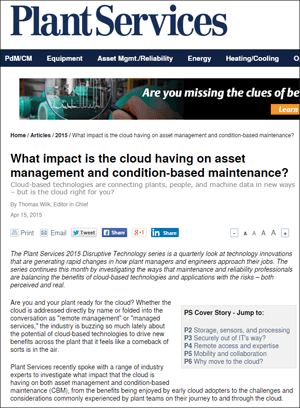The technology advancement of computer virtualization is having a tremendous impact on companies across the globe. And the consolidation of these servers into data centers “in the Cloud” is fundamentally changing how IT, operations and maintenance organizations within these companies operate.
 In a Plant Services article, What impact is the cloud having on asset management and condition-based maintenance?, Emerson’s Mike Boudreaux describes its impact on reliability programs.
In a Plant Services article, What impact is the cloud having on asset management and condition-based maintenance?, Emerson’s Mike Boudreaux describes its impact on reliability programs.
He explains:
The cloud itself is becoming a place where you can start small at a low-cost entry point and scale very big. Just getting access to computing resources and being able to deploy them very rapidly is one of the benefits of being in the cloud.
The key reasons process manufacturing and production facilities are looking to the cloud and remote monitoring services, according to Mike:
- Low-cost, highly scalable cloud-based storage and processing capability
- Innovative, lower-cost deployments of sensor technology, generally enabled by wireless capability
- More out-of-the-box connectivity solutions to the cloud
- The ability to connect experts to your data wherever they are and to do that in a sustainable way
- Collaboration capabilities enabled by mobile technology.
Mike notes:
A lot of cloud-based approaches are provided by vendors like Emerson to deliver services to customers, because users don’t have the expertise to do the reliability monitoring that they want to do or need to do to be competitive… These approaches may be particularly welcome by smaller organizations, which may not have the IT infrastructure and support to do the things that they want to do or need to do.
From a cost perspective:
…it’s extremely inexpensive to get data into the cloud and to store it there. The real cost is in processing the data. Once you store data on a hard drive, there’s not a whole lot of energy consumed to maintain that data on the hard drive. Once you start taking the data and using it to run software and algorithms on it, that’s where the main cost is.
From a security perspective:
We help set up conversations with our user’s IT organization, mostly to prove the independence of the networks and noninterference, as well as the security of the connectivity and the data… In the different cybersecurity zones, can someone hack onto the cellular networks and use that as a jumping point to other networks? Do we have the VPN and encryption from our gateway to the cloud, and do we have the right security in the cloud to ensure that someone can’t get into the network and obtain some sort of IP or otherwise sensitive data?
…
Microsoft is very open about their data center investment, their security model… It’s an impressive list of certifications they have from a security standpoint. That’s their competency, so when it comes to security management, they have certifications that generally most companies don’t have. If people are asking whether the cloud is secure, one of the things to ask is whether their on-premise servers and storage systems in their traditional architectures are more secure than what is in the cloud. Quite often, they’re actually less secure, because IT isn’t always a core competency.
From a reliability perspective:
…the data that we’re collecting is generally quite benign… The data being collected isn’t business proprietary data, and it’s not generally your control-system data. If you’re talking about acoustic or vibration data, it’s not as sensitive as process, temperatures, pressures, and flows. Sometimes the data will flow up through the control system if you’re doing some of the more advanced type of performance monitoring, but a lot of the data isn’t even process variable related.
And from a remote expert perspective:
If you’re doing statistical analysis of a variety of different forms, where a lot of it isn’t new, you may be using existing methods applied to a new domain. Reliability experts often don’t have the skills to do that kind of statistical analysis. In general it requires a high level of expertise, and that’s not always scalable at the facility level.
The article includes other perspectives from suppliers and industry analysts on the trend to the Cloud, so I thing you’ll find it well worth your time to read.
You can connect and interact with other reliability and maintenance professionals in the Reliability & Maintenance group in the Emerson Exchange 365 community.

